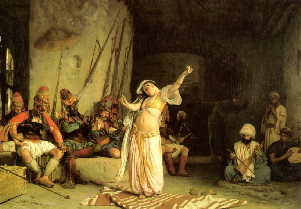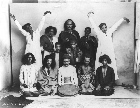|
|
|
 |
19th Century Egyptian Characters |  |
|
The Egyptian in general are fond of music; musician and dancers has been depicted in the ancient Egyptian tombs accompanied by the hieroglyphic text'" Make a good day, make a good day, Life only lasts for a moment, Make a good day." Which is the same idea, it will be noticed, as that of the feasters in the Bible, who said, "Eat, drink, and be merry, for tomorrow we die." The Egyptians have the habit of regulating their motions and reliving the dullness of their occupations, in various labors, by the songs and chants. Thus the Boatmen , in rowing ( this scene is depicted in kagamni tomb in Saqqara which dates back to 2450 B.C ) ; the peasants , in raising water ; the porter in carrying heavy weights ; and girls while baking . During the 19th century the female professional singers were called '' Awalim;"in the singular , '' Al'meh ,'' or ''A'limeh " which literally means '' learned female ." They were hired on the occasion of wedding of wealthy person. They proform in a small , elevated apartment called "Mughanna; " inside the hareem , which is only separated by a screen of wooden lattice - work from the man's apartment so they can hear their singing . The ط£طŒlim "often very highly paid. They have a very powerful effect that their audience , in the height of their excitement often lavish upon them sums which they can ill afford to loose . The Almah of the higher class knew, perfectly, all the new songs and dances they committed to memory the most beautiful elegiac hymns that bewailed the death of a hero, or the misfortunes incident to love. No festival was complete without their attendance; nor was there an entertainment in which the almah was not an ornament, or the chief excitement of pleasurable sensations. However, In the lower order, there was an inferior class who could not claim to be "Almah", whose imitations of the former were but very humble and cheap; without the knowledge, the elegance or the grace of the higher order (Almah) they had no choice but to frequent dance in the public places and the general walks; These fake dancers were usually of poor training and weak of mind. Most of the travelers in Ghawazee Were the public dancing girls of the most famous tribe, singular is Ghazeeyeh. They used to perform unveiled in the public streets, or in the court of the house, on a certain occasions like marriage or the birth of child. Their dances had "little of elegance; its chief peculiarity being a very rapid vibrating motion of the hips, from side to side, they exhibit a spectacle exactly agreeing with the description which Martial and Juvenal have given of the performance of the female dancers of Gades, in the early Roman emperors who had three distinct styles of dancing: Dancing girls were in such high regard that in 527 A.D. such as a dancing girl named Theodora; who married the Emperor Justinian (483-565) and became the "Empress Theodora". The similarity of the dance of Gades females and the ancient Egyptian dancers in very remote time ,confirm that it was introduced into Gades from the East , perhaps the modern Ghawazee are descended from the class of the dancers who amused the Egyptians pharaohs . Ghawazee used to perform in long, transparent gowns, beating drums or castanets in quick time, also wear various ornaments ; their eyes are bordered with the kohl ( black collyriuma ), and the tips of their finger , the palms of their hands, and their toes are usually stained with henna ( red dye ) . They always accompanied by musicians (mostly from the same tribe) whose instruments are the rababآ¹ with the tar; or the darabukkahآ² with the zummarah آ³: the tar is usually in the hands of an old woman. Many of them are extremely handsome; and most of them are richly dressed. Women, as well as men, take a delight in witnessing their performance. Between the Ghawazee they were a very low class ones that used to perform before private party of men. Wear nothing but semi transparent gown, open nearly half – way down the front, they were supplied with brandy, and considered the most abandoned one. Most of the Ghawazee keep themselves distinct from other classes by marriages persons from the same tribe. With the fact that most of them are Muslims , some of them accompanied the caravan of pilgrimages to Most of people persuading themselves that there is nothing improper in the dancing of the Ghawazee but the fact of its being performed by females so they hire male dancers who imitate the performance of the Ghawazee they were called " Khأ¤wals, " their general appearance is more feminine than masculine. They grow the hair of the head long; they were kohl in their eyes and henna in the hands. They often hired, on the occasion of marriage, birth of child, or circumcision. In 1798 the first organized expedition to Rabأ،bآ¹ or rebab: a stringed folk instrument played with a bow Darabukkeh: آ² a goblet-shaped drum played with the hands, called a doumbek, lit. Drum zummأ،rah آ³or the zemr: (mijwiz) a double reed wind instrument, about 14 inch long having a drone, with a shrill tone. |
||
| The dance of the Alamah 1863
Most of the travelers in |
||
 Jean Leon Gerome |
||
|
|
||
 Ancient Egyptian dancers& musician |
||
| Ghawazee 1880
public dancers ( Ghawazee) 1880 |
||
 "Khawals" male dancers 1880 |
||